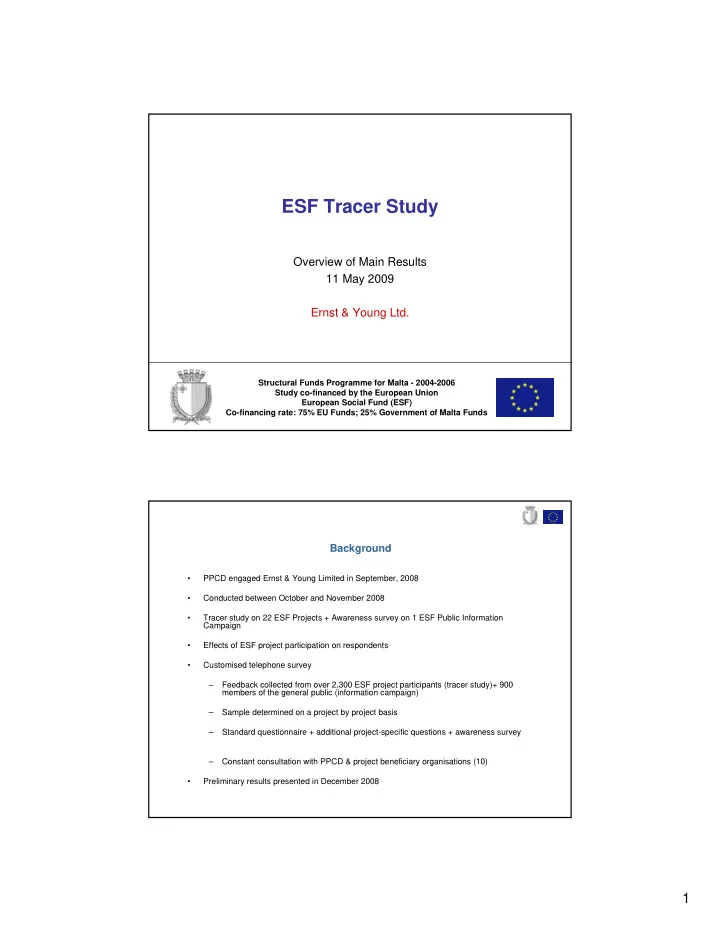

ESF Tracer Study Overview of Main Results 11 May 2009 Ernst & Young Ltd. Structural Funds Programme for Malta - 2004-2006 Study co-financed by the European Union European Social Fund (ESF) Co-financing rate: 75% EU Funds; 25% Government of Malta Funds Background • PPCD engaged Ernst & Young Limited in September, 2008 • Conducted between October and November 2008 • Tracer study on 22 ESF Projects + Awareness survey on 1 ESF Public Information Campaign • Effects of ESF project participation on respondents • Customised telephone survey – Feedback collected from over 2,300 ESF project participants (tracer study)+ 900 members of the general public (information campaign) – Sample determined on a project by project basis – Standard questionnaire + additional project-specific questions + awareness survey – Constant consultation with PPCD & project beneficiary organisations (10) • Preliminary results presented in December 2008 1
Number of respondents (per project) 1000 900 800 600 400 292 273 211 149 200 143 123 118 87 95 179 69 84 121 71 72 26 44 17 33 23 20 7 0 ESF 7 ESF 2 ESF 4 ESF 5 ESF 10 ESF 11 ESF 14 ESF 16 ESF 17 ESF 18 ESF 19 ESF 20 ESF 24 ESF 25 ESF 27 ESF 28 ESF 31 ESF 32 ESF 46 ESF 50 ESF 52 ESF 53 ESF 72 Conducted in three steps Interviewing Collection of project and Analysis of data documentation and surveying gathered and consultation with amongst reporting of project beneficiary project results organisations respondents 2
Focus Areas Best practices Employability Improved Skills Awareness Employment Effects of project (public info participation campaign) Results and Recommendations Overall participation Overall gender participation Male Female 48% 52% Overall location participation Gozo 10% Malta 90% 3
Employment Main ‘Employment’ findings: • Employment Rates: – Respondents in 12 projects increased employment rates, 6 saw a reduction, and 1 remained the same. • Project usefulness & contribution : – In all projects (except one) more than 50% of the respondents thought project participation potentially useful to career – Actual estimated (reported) contribution to career across projects (Females 27% – 84%, Males 38% - 100%) • Financial Earnings: – Increase in financial earnings differed across projects, and also by gender, very dependent on nature/content of project and target group • Satisfaction Rates: All projects showed very high overall satisfaction rates (between 82% and 99%) – Employability & Improved Skills Main ‘Employability’ findings: • Employability : – Reportedly improved for 28% - 91% of project-specific respondents. Responses linked to reasons behind individuals’ project participation. • New Skills : – Between 58% -100% of respondents indicated having achieved new skills through project participation • Future Challenges: – Number of challenges identified by respondents - potentially focus of additional future ESF projects 4
Improving employability & employment status: Identified Challenges • Family/personal reasons • Limited education/problems with English Gozo Specific: • Bureaucracy and seniority � Relative lack of • Courses not of a sufficiently opportunities advanced level � No child-care • Insufficient qualifications • Work does not offer flexible hours services/ opportunities • Opportunities are limited � Salaries • Lack of experience comparatively low • Problems related to disabilities Best Practices ‘Best Practices’ Main Findings: • Learning expectations: – Between 65% and 100% of respondents’ learning expectations were met • Project/Course logistics: – Most participants satisfied with overall course/project (as applicable) logistics: • Course content 47% to 100% • Course duration 41% to 93% • Course venue 65% to 96% • Training methodology 53% to 100% • Lecture timings 57% to 97% • Trainer approach and delivery 65% to 97% • Participants’ Recommendations: – Project-specific practical recommendations put forward by project participants 5
Respondents’ suggestions • Practical Sessions • Local training venues • Transport Subject Specific: • Age discrimination � Maths • Family-life balance � Maltese • Recognition � IT • Employer involvement • Experience � Higher level • Course duration � Follow-up courses • Streaming � Certification • Financial concerns • Sustainability • Target limited opportunities in Gozo Awareness Campaign survey • Survey focus on ESF 50 Information Campaign on Child-care services (carried out in early 2008) • Rate of awareness and change in perception and usage of child-care services • Telephone survey carried out in October 2008 amongst 900 respondents – general public with children/relatives up to the age of 10 – employers of employees with children up to the age of 10 • Different questionnaire to tracer study • Quota sample set to reflect gender proportions of Maltese population • Information also collated on a geographical basis (Malta/Gozo) 6
Survey Participation Overall gender participation Female Male 51% 49% Overall gender participation Malta 92% Gozo 8% Main Results • Campaign Awareness • 462 respondents out of 900 fell within the pre-determined categories • 50% (233 respondents) recalled campaign • Child-care Services Usage – Usage down amongst both male and female respondents from prior to campaign • Reasons for non-usage: – Alternative family arrangements 36% – Do not need child-care services – Not interested in working 14% • Campaign messages – Promote participation of women in the world of work : 48% – Promote benefits of chid-care services to parents 22% • Changes in attitudes as a result of campaign: – Yes 43% (100 out of 233) – No 57% (133 out of 233) 7
Respondents recommendations • Submissions included: – Need for better prices; – More promotion; – Childcare centres should have longer or more flexible hours; – Less jargon / use simpler words during campaign; – More information / advertising; – Financial help; – Increase the number of childcare centres, spread in different localities; – Centres for people with special needs; – More courses for childcarers; – Increase childcare services at work; – Campaign should also be addressed to single parents 8
Recommend
More recommend